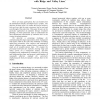Free Online Productivity Tools
i2Speak
i2Symbol
i2OCR
iTex2Img
iWeb2Print
iWeb2Shot
i2Type
iPdf2Split
iPdf2Merge
i2Bopomofo
i2Arabic
i2Style
i2Image
i2PDF
iLatex2Rtf
Sci2ools
VISUALIZATION
1995
IEEE
1995
IEEE
Enhancing Transparent Skin Surfaces with Ridge and Valley Lines
There are many applications that can benefit from the simultaneous display of multiple layers of data. The objective in these cases is to render the layered surfaces in a such way that the outer structures can be seen and seen through at the same time. This paper focuses on the particular application of radiation therapy treatment planning, in which physicians need to understand the three-dimensional distribution of radiation dose in the context of patient anatomy. We describe a promising technique for communicating the shape and position of the transparent skin surface while at the same time minimally occluding underlying isointensity dose surfaces and anatomical objects: adding a sparse, opaque texture comprised of a small set of carefully-chosen lines. We explain the perceptual motivation for explicitly drawing ridge and valley curves on a transparent surface, describe straightforward mathematical techniques for detecting and rendering these lines, and propose a small number of rea...
Isointensity Dose Surfaces | Radiation Therapy Treatment | Transparent Skin Surface | Visualization | VISUALIZATION 1995 |
| Added | 26 Aug 2010 |
| Updated | 26 Aug 2010 |
| Type | Conference |
| Year | 1995 |
| Where | VISUALIZATION |
| Authors | Victoria Interrante, Henry Fuchs, Stephen M. Pizer |
Comments (0)

